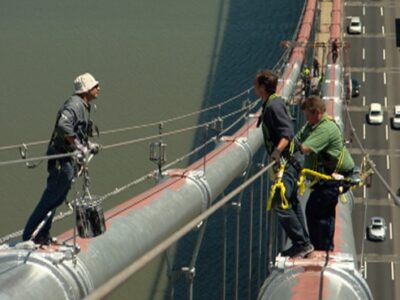On-the-job injuries are not something anyone wants. They hurt the worker because they incur lost wages. They also hurt the employer because it leads to a loss in productivity. In California, if a back injury occurs while the worker is working a shift, the worker may be able to collect workers’ compensation. Here are some things to consider.
Why Back Injuries Are a Major Concern in the Workplace
Back injuries make up one-third of all work-related injuries. This worker’s compensation claim costs up to $80,000, which covers medical costs and lost wages. A worker does have to prove that the injury occurred at work. Plus, the injury has to be within the scope of the worker’s duties. Injuries at work-related events, business trips, or while running work-related errands also qualify. Injuries at work, but in violation of company policies, and during the commute to work, do not qualify.
This data illustrates just how costly and common back injuries are. Even mild lumbar trauma can lead to extended time off work, lost income, and, in severe cases, long-term disability. That’s why it’s critical to understand the type of injury you’ve sustained and how it fits within the legal framework of California’s workers’ compensation system.
Types of Back Injuries Covered Under California Workers’ Compensation
California workers’ compensation law recognizes a wide range of spinal injuries, not only sudden trauma, but also repetitive motion injuries that develop over time.
Some qualifying back injuries include:
- Lumbar strains and sprains – often caused by lifting or twisting
- Herniated or bulging discs – are frequently diagnosed through an MRI
- Sciatica or nerve compression – often linked to radiating leg pain
- Spinal fractures or vertebral compression
- Degenerative disc disease – if aggravated or worsened by job duties
According to ICD-10 coding (used in medical claims), examples include:
- M51.2 – Other specified intervertebral disc displacement
- M54.5 – Low back pain
- S33.5 – Sprain and strain of lumbar spine
Understanding the medical classification of your injury is essential, as it helps justify both your claim and your potential benefits.
When Is a Back Injury Considered “Work-Related”?
California Labor Code Section 3600 outlines that for an injury to be compensable, it must arise “out of and in the course of employment.” In simple terms, this means your injury must be directly related to your job duties or occur while you’re performing tasks for your employer.
Examples of qualifying scenarios:
- Lifting boxes in a warehouse during your shift
- Driving a company vehicle on assignment
- Attending a mandatory off-site meeting or retreat
- Running a work-related errand
Scenarios that typically do not qualify:
- Injury during personal errands, even if on the clock
- Horseplay or substance-related behavior on the job
- Injuries sustained while commuting (unless exceptions apply)
Filing a Workers’ Compensation Claim in California: Step-by-Step
Exact laws that govern workers’ compensation claims vary from state to state. Additionally, so does the statute of limitations. A worker who believes that their injury occurred on the job at their workplace is advised to see a doctor as soon as possible. Then, they must notify their employer. To proceed with a claim, the next step is to file the proper paperwork.
To help clarify timelines and deadlines, here’s how the process works in California:
Workers’ Compensation Timeline Overview
| Step | Deadline | Description |
|---|---|---|
| Injury Occurs | Day 0 | Seek immediate medical help from a provider in your employer’s MPN. |
| Report to Employer | Within 30 Days | Fill out and submit Form DWC-1 to notify your employer. |
| Employer Files With Insurer | ASAP | An employer must forward the claim to their insurer. |
| Insurer Response | Within 14 Days | They must accept, reject, or issue a delay notice. |
| Employee Appeal (if denied) | Within 1 Year | File an Application for Adjudication with the DWC. |
The Medical Side: Diagnosis and Documentation
After your injury, you will be evaluated by:
- A physician in your employer’s MPN (Medical Provider Network), or
- A QME (Qualified Medical Evaluator), if there’s a dispute.
Medical evidence plays a critical role. Be sure your doctor:
- Describe your condition using diagnostic terms
- Orders imaging (MRI, X-ray, CT scans) where needed
- Links your injury to your job tasks directly in writing
- Lists work restrictions, if applicable
Without this medical foundation, even the best-argued legal case can falter.
What Happens If the Employer or Insurer Challenges Your Claim?
Since workers’ compensation claims are so expensive, employers have to do their due diligence, too. The legal team for the company is going to go through all the paperwork submitted by the worker. Therefore, the paperwork has to be completely and properly filled out. The evidence has to be solid, including the diagnoses from the physician. Workers with back injuries who are going to push forward with a workers’ compensation claim are encouraged to hire legal representation that may not leave any holes in the case.
In real-world situations, disputes often arise when:
- The injury was not reported promptly
- There is a lack of medical clarity or diagnosis
- Surveillance suggests non-work-related causes
- The employer claims the injury occurred off the clock
Benefits You May Be Entitled To in California
In California, injured workers may receive:
- Medical treatment at no cost (within the MPN)
- Temporary disability benefits (approx. 66% of lost wages)
- Permanent disability payments, based on impairment ratings
- Supplemental Job Displacement Benefits (SJDB) – retraining vouchers
- Settlement payouts through:
- Stipulations with Request for Award
- Compromise & Release (C&R)
FAQs: California Back Injury Workers’ Compensation
How do I start a workers’ comp claim for a back injury in California?
Begin by notifying your employer immediately. Fill out Form DWC-1 and seek treatment through your employer’s Medical Provider Network (MPN). You may also want to consult an attorney to guide the process.
Can I be fired for filing a workers’ comp claim in California?
No. California law prohibits retaliation against employees who file a workers’ comp claim. If you’re fired or harassed, you may be entitled to additional compensation.
What should I do if my claim is denied?
If your claim is denied, file an appeal through the Division of Workers’ Compensation (DWC) and request a hearing. A lawyer can help strengthen your case with supporting medical evidence.
How much compensation can I get for a back injury?
Compensation varies based on medical costs, time off work, and permanent impairment. On average, settlements for back injuries in California range from $40,000 to $80,000 or more.
Do I need a lawyer for a workers’ comp case?
While not mandatory, having an experienced California workers’ comp attorney can significantly increase your chances of a successful claim and a higher settlement.
How long does it take to get paid after filing?
If approved, temporary disability payments usually begin within 14 days of the employer receiving the physician’s note indicating you can’t work.
Why You Need an Attorney Who Knows California Work Injury Law
Filing a workers’ compensation claim is not just paperwork, it’s a legal process. One missed step or loosely written medical report can mean the difference between approval and denial.
At Hussain Gutierrez Law, we specialize in helping injured workers:
- Build medically sound claims
- Fight back against denials
- Maximize settlements through negotiation
- Represent clients at hearings and appeals
Take Action Now – Get a Free Consultation
If you’ve suffered a back injury on the job in California, don’t wait. Time limits matter, and your benefits depend on swift action.
Call Hussain Gutierrez Law today to speak with a dedicated workers’ compensation attorney.
Visit hussaingutierrezlaw.com to schedule your free consultation and start building your case today.



